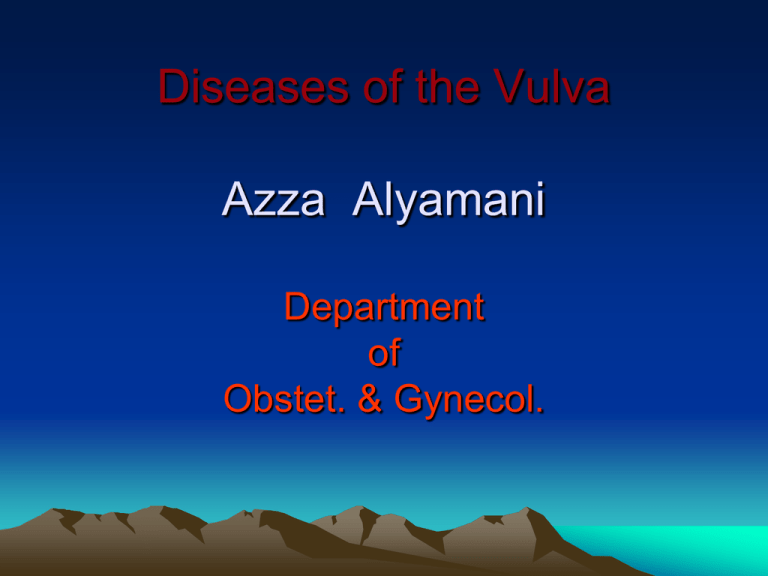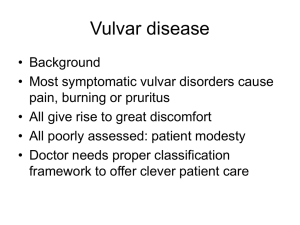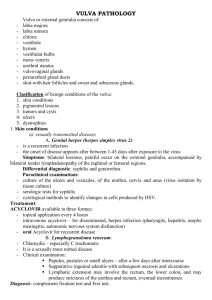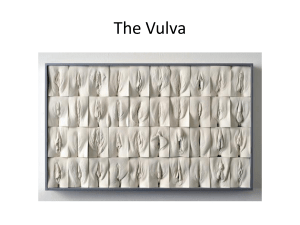
Diseases of the Vulva
Azza Alyamani
Department
of
Obstet. & Gynecol.
Vulvo-vaginal problems are among 10 leading
disorders encountered by primary care clinicians.
* Benign lesions of the vulva are mentioned in three
categories :
1. Epithelial conditions.
2. Benign neoplastic disorders.
3. Dermatologic disorders.
* VIN
* Cancer vulva
Benign Conditions
of the Vulva
(1) Epithelial Conditions
1) Lichen simplex .
2) Lichen sclerosis.
3) Lichen planus,
erosive lichen planus.
1) Lichen Simplex
“ squamous cell hyperplasia “
* it is a local thickening of the epithelium resulting
from a prolonged itching .
* symptoms :
pruritus and pain.
* signs :
white or reddish thickened ,leathery ,raised surface.
usually discrete lesion but may be multiple.
* treatment :
• moderate-strength steroid ointment.
• antipruritic agent.
lichen simplex
2) Lichen Sclerosis
* it is a chronic progressive disease which constrict
and destroy the normal genital anatomy . In the
long term ,labia minora are lost ,labia majora
flatten ,clitoris becomes inverted .
* frequently found on the vulva of postmenopausal
women & can involve all the genital area from
mons to the anal area.
* combinations of lichen sclerosis & epithleal
hyperplasia or carcinoma are possible.
* symptoms:
intense pruritus , dyspareunia and burning pain.
* signs:
thin inelastic atrophic skin ,white with a crinkled ,
tissue paper appearance.
* diagnosis:
multiple biopsies is necessary.
it reveals a thin atrophic epithelium with
inflammatory cells lining the basement
membrane.
* treatment:
● potent topical steroids. 80% of lesions respond.
long term therapy with low potent steroids may
be necessary.
● other local treatments are: esrtogen cream and
anaesthetics.
lichen sclerosis
advanced
3) Lichen planus
* it is a purplish ,polygonal papules that may
appear in their erosive form.
* it involve the vulva ,the vagina and the mouth
( vulval – vaginal –gingival syndrome ).
* symptoms:
vulval burning , severe dyspareunia when
vaginal stenosis develop in advanced stages.
* treatment:
topical and systemic steroids .
erosive lichen planus
of vulva & vagina
lichen planus
(2) Benign Neoplastic condions
1) epidermal inclusion and sebaceous cysts.
2) vulvar varicosities.
3) fibromas and lipomas.
4) clitoromegaly.
1) epidermal inclusion & sebaceous cysts
* they are nontender , mobile , spherical ,slow
growing cysts located below the epidermis.
* sebaceous cysts are firmer bec. they are
filled with dry caseous material.
* treatment :
most of inclusion cysts require no ttt. if they
are asymptomatic, or surgical excision.
2) Vulval Varicosities
Can enlarge especially during pregnancy
to cause discomfort and carry a possible
risks for rupture or thrombosis.
3) Fibromas and Lipomas
Fibromas:
* are the most common benign solid tumors
that arise in the deeper connective tissue
of the vulva.
* they are slow growing 1–10 cm in diameter,
but may become huge .
Lipomas:
* slow growing tumors composed of adipose
cells.
Vulval Fibroma
4) Clitoromegaly
* may develop after birth in response to
excessive androgen exposure . It is a sign
virillization.
* diagnosed when the clitorial length exceeds
30 mm or the width at the base exceeds
10 mm.
clitoromegaly
( 3) Dermatologic Disorders
1) Psoriasis.
2) Behcet ′s syndrome.
3) Crohn ΄s disease .
4) Acanthosis nigricans .
1) Psoriasis
appears velvety but lack the characteristic
scaly patches found on the knees & elbows.
2) Behcet ′s syndrome
* ulcers in the vulval , oral and ocular areas.
* genital lesions can result over time in a scarred
vulva.
* etiology : is unknown.
* diagnosis : based on the concurrence ulcers in
vulva ,mouth & ocular involvement ,the
recurrent nature of the disease and exclusion
of syphilis and Crohn’s disease.
* treatment : no effective ttt.
oral ulcer
vulvar ulcer
Behcet′ s disease
3) Crohn’s disease
* vulval ulcers can precede the development
of GIT ulcerations .
* vulval ulcers are slit-like or knife – cut ulcers
with prominent edema. Draining sinuses and
fistulas to the rectum may occur.
4) Acanthosis nigricans
* most commonly found in the axilla or the
nape of the neck then vulva.
* characterized by its darky pigmented
velvety or warty surface .
* etiology : related to insulin resistance.
Vulval Neoplasms
Introduction
* uncommon 5 % of female genital tract malign.
most tumors are squamous cell carcinomas ,may
be melanomas , adenocarcinomas and sarcomas.
* postmenopausal women ,mean age 65 years.
* a history of chronic vulval itching is common.
Epidemiology
Two different etiologic types of vulval cancers :
1. A less common type:
* in younger women .
* related to HPV infection and smoking.
* commonly associated with VIN .
2. The more common type:
*
*
*
*
in old women .
unrelated to HPV infection or smoking.
concurrent VIN is uncommon.
long standing lichen sclerosis is common.
5% of patients have +ve serologic tests for
syphilis , lymphogranuloma venereum
and granuloma inguinale.
Vulval Intraepithelial Neoplasia (VIN)
2 types of VIN :
1. squamous cell carcinoma in situ
VIN III or Bowen’s disease.
2. Adenocarcinoma in situ
VIN III or Paget’s disease.
Squamous cell carcinoma in situ:
VIN III ( Bowen′s disease )
* mean age 45 years.
* symptoms:
50% asymptomatic.
itching is the most common symptom.
* signs:
most lesions are elevated ,white ,red ,pink ,
brown or grey in color.
20% of lesions are warty in appearance.
* diagnosis:
1.careful inspection of the vulva in bright
light and with the aid of a magnifying glass.
2. 5% acetic acid
aceto white areas.
* treatment :
1. local superficial excision.
with margins of 5 mm are adequate.
2. skinning vulvectomy in extensive lesions.
3. laser therapy
if lesions involves the clitoris , labia minora
or perineal area.
Adenocarcinoma in situ
VIN III ( Paget′ s disease )
* occurs in white postmenopausal elderly women.
also occurs in the nipple area of the breast.
* 20% is associated with adenocarcinoma.
* symptoms:
itching and tenderness are common.
* signs:
well demarcated and eczematus with white
plaque like lesions.
* growth may progresses beyond the vulva to the
mons pubis ,buttocks & thighs.
* diagnosis
histologically:
adenocarcinoma in situ characterized by
large ,pale , pathognomonic Paget’ s cells,
typically located both in the epidermic and
in the adnexal structures.
* treatment:
1. local superficial excision.
with margins 5-10 mm.
2. laser therapy
in recurrences which are common.
Paget′ s disease
Invasive Cancer Vulva
A. Squamous cell carcinoma
* 90% of vulval cancers.
* symptoms:
• vulval lump or ulcer.
• long standing pruritus.
* signs:
• raised ,ulcerated ,pigmented or warty lesion.
however , ulceration is usually an early sign.
• most lesions occur on labia majora and labia
minora. Less common sites , the clitoris
or the perineum.
• 5% of lesions are multifocal.
squamous cell carcinoma of vulva
* spread :
• direct extension
to adjacent structures as the vagina , urethra
and anus.
• lymphatic embolisation
inguino femoral nodes.
= initially to the superficial inguinal LN.
= then to deep femoral LN. located medial
to the femoral vein, LN of Cloquet′s is
the most common of this group.
=then spread occurs to pelvic nodes
especially the external iliac LN.
= LN metastases occurs 50% in cancer vulva.
5% of patients have metastases to pelvic
LN , usually 3 or more +ve unilateral
inguino femoral LN.
• hematogenous
occurs late to the lungs , liver and bone rarely
in the absence of lymphatic metastases.
FIGO Staging of Cancer Vulva
Stage I
Ia
Ib
Stage II
Stage III
Tumor limited to the vulva or perineum or both ,and
2 cm or < in diameter ,and no nodal metastases.
as above + stromal invasion < 1mm.
as above + stromal invasion > 1 mm.
Tumor limited to the vulva or perineum or both ,and
> 2 cm in diameter ,and no nodal metastases.
Tumor of any size with :
• adjacent spread to the urethra &/or vagina &/or
anus
• unilateral regional LN. metastasis or combination.
Stage IV
IVa Tumor invades any of the following pelvic :
upper urethra ,bladder mucosa ,rectal
mucosa ,pelvic bone or bilateral regional
node metastasis ,or a combination.
IVb
Any distant metastasis including pelvic
lymph nodes.
Management
A) Early vulval cancer
* Stage I a
( penetration depth < 1mm below the basement
membrane & no nodal metastases )
radical local excision é surgical margins
1cm, patient do not need groin dissection.
* Stage I b & Stage II
( penetration > 1mm )
radical local excision +ipsilateral inguinal
femoral lymphadenectomy if the lesion is
unilateral and bilateral groin dissection in
the
midline
lesions .
B) Advanced vulval cancer
* Stage III
( involves the proximal urethra ,anus or rectovaginal
septum )
radical vulvectomy which includes a bowel,
urinary stroma or rectovaginal septum.
+ bilateral groin dissection.
Preoperative radiation or chemo-radiation should be
used to shrink the 1ry tumor ,followed by more
conservative surgical excision.
C) Positive lymph nodes
Radiation
used with > one nodal mico metastasis (<5mm),
or evidence of extra nodal spread .
postoperative radiation to both groins
and to the pelvis.
Prognosis:
= it correlate significantly with LN status.
with –ve nodes have a 5-ys survival rate is 90%.
with +ve nodes have a 5-ys survival rate is 50%.
= patient with no involved node have a good
prognosis regardless of stage.
Malignant Melanoma
* the 2nd most common vulvar cancer.
* may arise de novo or from a preexisting nevus.
commonly involve labia minora or clitoris.
* occurs in postmenopausal white women.
* diagnosis :
any pigmented lesion of the vulva requires
excisional biopsy for histopathology.
* usually smaller lesions and tend to metastasized
early.
malignant melanoma of the vulva
* prognosis:
correlates to the depth of penetration into the
dermis. The 5-ys survival rate is 30%.
* superficial lesion
radical local excision alone
with margins of 1 cm, is adequate.
* deeper lesions 1 mm or >
radical local
excision + ipsilateral inguinal femoral
lymphadenectomy.
* adjuvant therapy:
= nonspecific immuno stimulants.
= chemotherapy.
= vaccines.
Thank You












